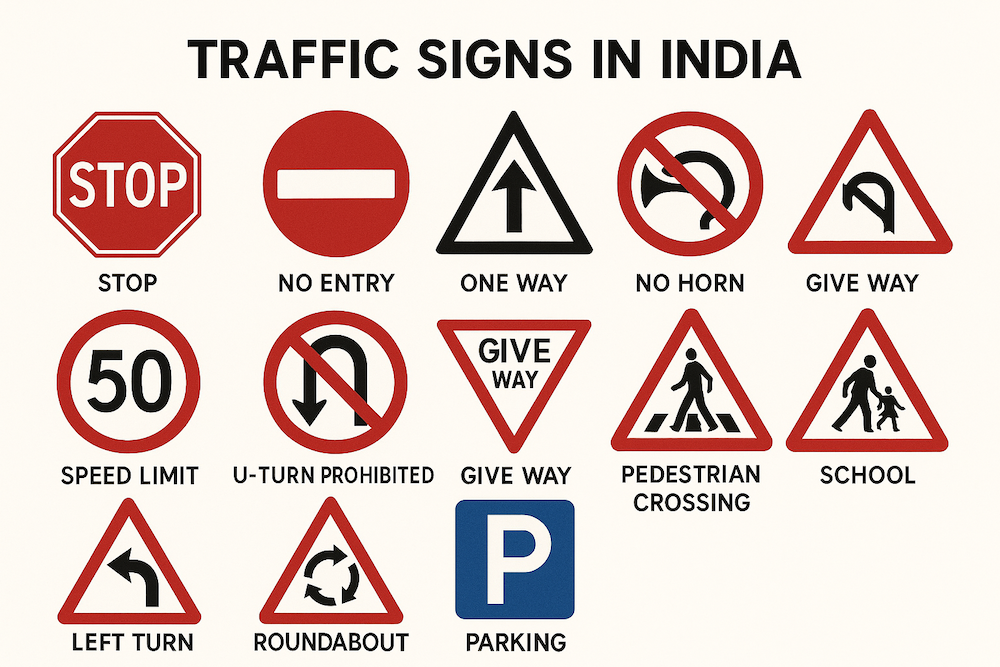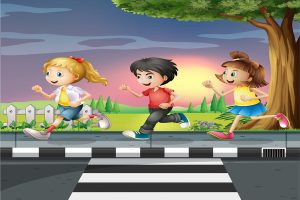Road safety is one of India’s most crucial aspects of child education. With increasing traffic, bustling streets, and various modes of transport, children must understand the basic road safety rules. Educating kids about road safety prevents accidents and teaches them to be responsible pedestrians, cyclists, and passengers. This article explores the essential road safety rules for kids in India, covering everything from pedestrian safety to traveling in vehicles.
Understanding the Landscape of Road Safety in India
The impact of road accidents cannot be overstated. Before we dive into the specifics of the issue, it is important to understand the gravity of it. Road accidents in India, tragically claim countless lives every year. Particularly, among children. India’s contribution to road fatalities is alarming, accounting for 11% of deaths worldwide despite owning only 1% of the world’s vehicles. These shocking figures call for an urgent need to take road safety measures effectively. These issues need to be highlighted in public education campaigns to prevent further loss of life.
Why Kids Should Learn Road Safety Rules?
Well, it is not just about learning the safety rules. It is about staying safe. Imagine your little one walking out alone, trying to cross the road without looking both ways. Scary right? By teaching them these safety rules, we are protecting them and giving them the power to protect themselves. It is never too early to build good habits. By teaching them road safety rules early on in life, we are helping them grow up to be responsible citizens of the country and safe road users.
14 Crucial Road Safety Rules for Children
Teaching your child traffic rules can be a simpler task if you explain it to them in a fun and interesting way.
Follow Traffic Signals

Tell your child to think of the traffic light as a friendly cop, who tells them when to go, when to stop, and when to slow down. You should put it across as, “Just as you listen to your parents, you should listen to these signals.”- Red Light: When the right is red. STOP! It is like a warning to stop moving.
- Yellow Light: When the light is yellow, you SLOW DOWN! You will either have to go next or stop, depending on the situation and the light that follows.
- Green Light: You may GO! But be careful, look both ways before crossing.
Let your little ones know that they can keep themselves and others safe by following these rules.
Follow the Road Signs

Kids crossing the road Make your child aware that road signs are like friendly guides who point you in the right direction. These are similar to street signs but for cars and people
- No Entry Sign: This sign means, stay out, and do not go that way.
- Speed Light Sign: This sign tells you how fast you can drive, if you are too fast you must slow down.
- Pedestrian Crossing Sign: You have to look out for people crossing the road here, you have to slow down and be ready to stop. Tell your children that they will grow up to be smart and safe road users if they follow these signs.
Always Use Pedestrian Crossings

Kids Using Pedestrian Crossings Educate your child to always cross the road at the pedestrian crossing. It is safer than crossing anywhere else.
- Zebra Crossing: The black and white lines on the road are called Zebra Crossing. This is where you cross the road but before that, you must look for cars and wait for them to stop.
- Traffic Lights: Wait for the green light to cross.
By choosing the pedestrian crossing, you are choosing the safest way to cross the road.
Always Hold Hands While Crossing

Kid holding the elder hand while crossing the road Teach children the importance of holding an adult’s hand while crossing roads, emphasizing the significance of designated pedestrian crossings and traffic signals. Let them know that the road is full of fast-moving cars and trucks. Holding an adult’s hand while crossing the road is like having a superhero by your side to protect you.
- Safety First: Having an adult by your side will keep you safe and guide you correctly.
- Avoid Distractions: When you are holding an adult’s hand, you are less likely to get distracted by things around you or sounds.
- Following Rules: Holding hands will help you follow rules like the pedestrian crossing and green light rules correctly.
The road is not a playground. It’s important to be careful and stay safe. So, next time you’re crossing the road, make sure you’re holding an adult’s hand.
Look Left-Right-Left

Kid checking both the side of road before crossing Make it a fun thing to explain to your children about traffic rules. Like, going on the road is like playing a game of ‘spot the car’. You need to look left, then right and left again before crossing. This helps you stay safe if any cars are moving on the road.
- Avoid Accidents: By looking left, right, and left you can see if any cars, bikes, or other vehicles are moving and stop before you cross to avoid getting hurt.
- Be a Responsible Pedestrian: Following this rule makes you a responsible pedestrian.
It is always better to be safe than sorry. So before you cross the road, take a moment to look left, right, left again.
Stay Visible with Reflective Gear
Have you ever seen those clothes that glow in the dark? They are called reflective gear, get these for your children and make sure they put it on. Explain to them that, these are your shields during the night hours.
- Being Seen: During the night, you may not be visible to drivers. Earing reflective gear will make you stand out and easy to spot.
- Staying Safe: By being visible, you can stay safe and avoid accidents.
So, next time you are walking or cycling in the dark, make sure you put on your reflective gear as a small step towards staying safe.
Stay on the Sidewalks

kid walking on sidewalk Instruct children to use sidewalks whenever available, steering clear of the main road. Tell them these are safer to walk on better than roads where cars and bikes zoom by.
- Avoid Danger: Sidewalks keep you away from busy roads, protecting you from accidents.
- Following Rules: Walking on the sidewalk is the right thing to do, it helps keep everyone safe.
Walking on the sidewalk is a good way to keep yourself protected, so next time you are out and about stick to walking on the sides.
Be Cautious Around Parked Vehicles

Warn them about the dangers of darting between parked cars and the importance of staying visible to drivers.- Dooring Accidents: You need to be visible to drivers so that they do not suddenly open doors without looking. Getting hit by a door can be painful.
- Unexpected Traffic: Be aware of people who suddenly pull out of parking spots.
To stay safe always walk a little away from parked cars and keep your reflexes quick in case a car door opens or a car moves.
Stay Away from Stray Animals on the Road
Stray animals like cats and dogs sometimes wander off on the road, though they may seem harmless they can come out of nowhere.
- Safety First: Stray animals may bite or scratch you if they feel cornered.
- Distractions: Focusing on a stray animal can distract you from other vehicles on the road. This can cause accidents.
It is best to avoid stray animals on the road, if you see one, try to cross the road fast and quick.
Board and Exit Transport Safely

People boarding the bus Teach them how to safely board and exit public or private transportation, emphasizing waiting for the vehicle to come to a complete stop.
- Preventing Accidents: If you rush and are careless, it can lead to falls and injure you.
- Respecting Others: If you are patient and orderly, you are making the experience better for everyone. Wait for your turn, hold on to handrails, and look before you walk.
By following these simple steps, you can ensure your safety and a pleasant journey.
Educate About Stranger Danger
Warn your kids about strangers. It is important to be cautious around strangers because not everyone is a friend. Here are the main things you should tell them about.
- Do not talk to strangers
- Do not accept gifts or rides from strangers
- If you ever feel threatened or unsafe, yell for help.
- Trust your instincts, if something feels wrong. It probably is.
No Running While Crossing the Road

kids running on the sidewalk Running across the road is a dangerous thing to do. If you are running, it is hard to stop suddenly when a car comes.
- Reduced Reaction Time: Running limits your ability to react quickly in a dangerous or unexpected situation.
- Increased Risk of Accidents: It is easier for drivers to misjudge the speed of a running pedestrian, which makes you susceptible to accidents.
Always be calm and careful when crossing the road.
Never Cross the Road at The Curves
Explain to your child that crossing the curves can be tricky. Drivers may not be able to see you if you cross on the curves.
- Limited Visibility: Drivers may not be able to see you coming.
- Increased Risk of Accidents: Sudden appearances can surprise the drivers, and their responses may not be as quick, which can cause you to get hurt.
Always find a straight section of the road where you are more visible to the drivers.
Give Way to Emergency Vehicles

Emergency vehicle passing by Your children must be told that emergency vehicles like ambulances or fire trucks are rushing to help people, always move aside and give them a way to pass by quickly.
- Saving Lives: Emergency vehicles are always moving to save lives, and every second is important.
- Following the Law: It is illegal to block the way when an emergency vehicle is trying to pass by.
If you hear a siren behind you, move aside and stop till the emergency vehicle has gone ahead safely.
Traffic Rules Image
This image displays important traffic signs commonly found on roads in India, including stop, no entry, speed limit, pedestrian crossing, give way, and school zone indicators. These visual symbols are designed to help drivers, cyclists, and pedestrians recognize and follow safety rules for smooth and secure travel. Understanding these signs is essential for children to learn road safety basics and confidently navigate streets.

The Role of Parents in Maintaining Road Safety
In a country where roads buzz with life and diversity, nurturing responsible road habits in our children becomes a cultural responsibility. Integrating these simple yet effective road safety rules into our children’s routines not only ensures their safety but also contributes to building a conscientious and safety-minded society.
Parents, caregivers, and educators serve as the primary role models for children. When adults consistently demonstrate safe road behaviors, such as using crosswalks, obeying traffic signals, and displaying patience and courtesy while driving or walking, children internalize these actions as norms.
Every interaction on the road is an opportunity for adults to teach valuable lessons. For instance, explaining why it’s essential to wait for the pedestrian signal or discussing the importance of looking both ways before crossing reinforces these behaviors as critical safety measures.
By weaving road safety education into our parenting and early learning strategies, we not only protect our children but also sow the seeds for a safer, more aware future generation on India’s vibrant streets.
When Can My Child Cross the Road Alone?
All children are different, so deciding between letting your child cross the road alone can be a tough decision to make. The decision needs to be made as per their development and depending on how safe the road around where you live is. Your child is not ready to navigate through roads alone, until they are completely aware of the road safety rules, and can put them in practice. They should also be able to judge how fast the traffic is moving, and when it is safe for them to cross the roads.
Educational Initiatives in Schools and Communities to Promote Road Safety
The collaboration between schools and communities stands as a robust foundation for nurturing road safety awareness among children. Integrating road safety into the curriculum through workshops, simulated scenarios, and peer-led programs can be an impactful way to drive the message amongst children. By embedding these lessons across subjects and empowering students to practice safety measures in real-time settings, schools become pivotal in instilling lifelong road safety habits.
Complementing this, community-oriented initiatives open the collective strength of local authorities, NGOs, and businesses. Through workshops, events, and advocacy for improved infrastructure, communities extend road safety education beyond classroom walls. These endeavors engage parents, local businesses, and transportation services, fostering a holistic environment that reinforces responsible road behaviors at home, on the streets, and within the broader community. Together, this combined approach not only educates children but also creates a culture where safety on the roads becomes a shared commitment and priority.
Empowering our children with the knowledge and practices of road safety isn’t just a responsibility; it’s an investment in their well-being. By imparting these essential road safety rules, we can significantly reduce the risks our children face on the streets of India.
At KLAY, road safety forms an integral part of the curriculum where little children learn about road and travel safety guidelines.
Remember, nurturing these road safety rules is not a one-time lesson but a continuous practice that shapes our children’s attitudes and behaviors toward road safety, making their journeys safer and more enjoyable.

























280 Comments
Subscribe to our newsletter
[contact-form-7 id="12706" title="Newsletter Form for post page"]Our Related Blogs
Yoga Benefits, Activities, and Poses for Preschoolers
For preschoolers, yoga isn’t about perfection but about giggles and benefits. So, are you curious how a simple stretch can support a child’s focus, flexibility, and emotional well-being? Let’s roll...
Year-End Reflection and Goal Setting for Children
Parenting is a journey filled with the brightest moments and valuable lessons, both for us and our children. As the year draws to a close, it’s the perfect time to...
Why Residents of Malibu Town, Gurgaon Choose KLAY for Their Little Ones?
Choosing the right preschool or daycare is one of the biggest decisions for any parent, especially in a community as close-knit and discerning as Malibu Town, Gurgaon. Over the years,...